Trends: US teens and social media
Pew Research Center recently performed a survey that examined the behavior trends and attitudes of US teenagers age 13 to 17 years old, as well as those of their parents, toward technology and social media. Here’s some stand-out stats.
The survey found that a nearly all (approximately 92%) are accessing the internet and social media sites daily using their mobile device with 24% of all teens accessing the internet ‘almost constantly’. On top of this, 70% of the teens surveyed have access to 4 or 5 connected devices (desktop or laptop computer, smartphone, tablet gaming console).
In both age groups surveyed (13-14 and 15-17 year olds), female teens access the internet via mobile at a higher rate than male teens. The demographic group most active among both genders were girls between 15 and 17 years of age.
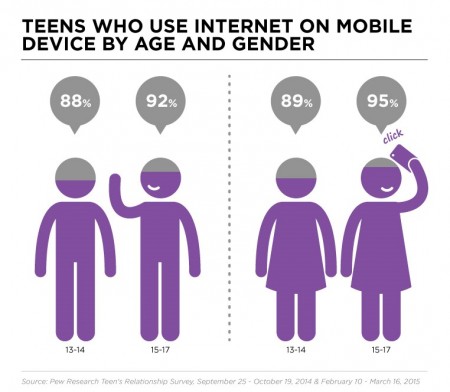
The convenience of ‘always connected’ mobile devices allow teens to go online more frequently. The survey showed that 92% of all teens access the internet at least once daily with 56% connecting several times a day.
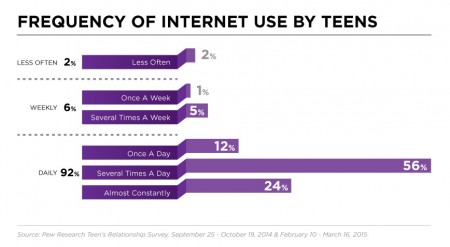
Looking at ethnicity, African-American teens were found to be considerably more likely than Hispanics or Caucasians to go online via mobile. The survey found that nearly all African-American teens use mobile to access the internet at least occasionally.
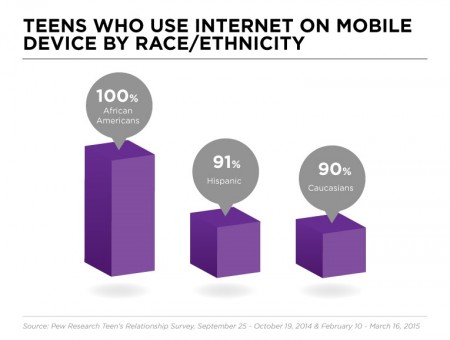
In terms of platform usage, Facebook is still by far the most popular social network while over half of American teens also now use Instagram. Most teens (71%) use more than one of the social networks listed above, which is in line with what Pew previously identified across all age groups (52% of online adults now use two or more social media sites up 10% from previous years according to another Pew Research Study).
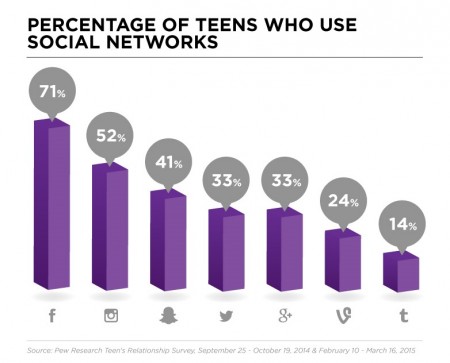
Based on the survey results, teens’ social media usage by platform is impacted by gender. Girls were more likely to say they use Instagram most (6% more likely) and Tumblr (5% more likely) while boys were significantly more likely to state they use Facebook most (9% more likely). The largest variance in social platform use by gender, however, is on Pinterest where 33% of girls (led by the 15-17 year old age group) stated they use pinboards on Pinterest versus only 11% of teen males.
The survey also revealed that socioeconomic status impacts the use of specific social media channels. Wealthier teens showed less of a tendency to use Facebook and were more likely to use Instagram and Snapchat while lower income teens gravitated toward Facebook and were much less likely to use other channels as observed below. Similarly teens from families with somewhat lower levels of education reported being more likely to use Google+ at 35%. (Overall Google+ usage among the teens surveyed is surprisingly high with 33% of all teens surveyed stating they use the network.)
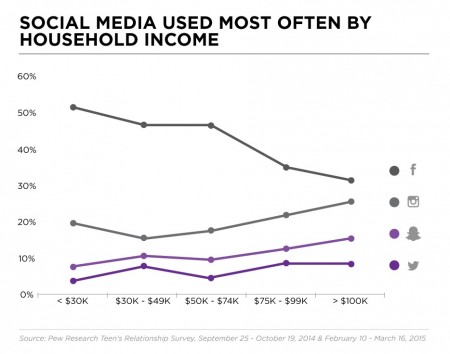
Besides the mainstream social media channels covered above, use of mobile messaging & use of messaging apps is growing rapidly. Texting was especially important to the teens surveyed with 90% of those with phones exchanging texts. The average teen was found to send/receive 30 texts per day. The study found that 73% of teens with smartphones use apps like Kik or WhatsApp and overall 33% of those with phones now have these apps. Anonymous apps and websites are reportedly used less often, with only 11% of teens with cell phones reporting they use apps such as Whisper, Yik Yak or Ask.FM.
The survey also reviewed respondents’ social footprint. The typical teen has 145 Facebook friends (the overall median is 200 friends) with girls reporting roughly 75 more connections than boys on average. Teen Instagram users report having 150 followers on the channel on average (194 is the overall median), again females lead the way with 200 followers reported compared to 100 on average for male teens. Twitter is the only channel where teens over index in terms of followers compared to the overall median of 61 followers. The average teen has 95 followers, with girls once again outpacing boys 116 followers to 61. For each channel the older age demographics reported significantly more connections than the younger teens age 13-14.
The study provides a wealth of additional information on the online behavior of American teens and we encourage you to read more at the Pew Research Center Survey.